Effects of Partial Organic Fertilizer Substitution on Grain Yield, Nitrogen Use Efficiency, and Physiological Traits of Rice in Northeastern China
Abstract
1. Introduction
2. Materials and Methods
2.1. Experimental Site and Soil Properties
2.2. Tested Material
2.3. Measurement and Sampling
2.3.1. Yield and Yield Components
2.3.2. Relative Chlorophyll Content (SPAD)
2.3.3. Photosynthetic Rate of Flag Leaf
2.3.4. Determination of Dry Matter Weight
2.3.5. Determination of N Uptake
2.4. Statistical Analysis
3. Results
3.1. Grain Yield and Yield Components
3.2. Shoot Physiological Traits
3.2.1. Leaf Area Index
3.2.2. Chlorophyll Content (SPAD Value) in Flag Leaves
3.2.3. Net Photosynthetic Rate in Flag Leaves
3.2.4. Dry Matter Accumulation and Translocation
3.3. Nitrogen Parameters
3.3.1. Nitrogen Index
3.3.2. N Accumulation in Main Growth Periods
3.3.3. NRE (N Recovery Efficiency) in Main Growth Periods
3.4. Correlation of Shoot Traits with Grain Yield and Nitrogen Parameters
3.5. Comprehensive Assessment of the Different N Fertilizer Management Strategies
4. Discussion
5. Conclusions
Author Contributions
Funding
Data Availability Statement
Acknowledgments
Conflicts of Interest
References
- Xiong, J.; Ding, C.Q.; Wei, G.B.; Ding, Y.F.; Wang, S.H. Characteristic of Dry-Matter Accumulation and Nitrogen-Uptake of Super-High-Yielding Early Rice in China. Agron. J. 2013, 105, 1142–1150. [Google Scholar] [CrossRef]
- Peng, S.B.; Tang, Q.Y.; Zou, Y.B. Current Status and Challenges of Rice Production in China. Plant Prod. Sci. 2009, 12, 3–8. [Google Scholar] [CrossRef]
- Chen, Z.K.; Liu, F.D.; Cai, G.Y.; Peng, X.S.; Wang, X.L. Responses of soil carbon pools and carbon management index to nitrogen substitution treatments in a sweet maize farmland in south China. Plants 2022, 11, 2194. [Google Scholar] [CrossRef]
- Hu, J.Y.; Yang, Y.; Zhang, H.Y.; Li, Y.H.; Zhang, S.H.; He, X.H.; Huang, Y.F.; Ye, Y.L.; Zhao, Y.N.; Yan, J.Y. Reduction in nitrogen rate and improvement of nitrogen use efficiency without loss of peanut yield by regional mean optimal rate of chemical fertilizer based on a multi-site field experiment in the north China plain. Plants 2023, 12, 1326. [Google Scholar] [CrossRef]
- Dong, J.S.; Shen, X.J.; Li, Q.; Xue, Z.; Hou, X.F.; Miao, H.C.; Ning, H.F. Irrigation and fertilization scheduling for peanut cultivation under mulched drip irrigation in a desert–oasis area. Plants 2024, 13, 144. [Google Scholar] [CrossRef] [PubMed]
- Zhao, C.; Ni, H.F.; Zhao, L.; Zhou, L.; Hidalgo, O.B.; Cui, R.Z. High nitrogen concentration alter microbial community in allium fistulosum rhizosphere. PLoS ONE 2020, 15, e0241371. [Google Scholar] [CrossRef]
- Galloway, J.N.; Townsend, A.R.; Erisman, J.W.; Bekunda, M.; Cai, Z.; Freney, J.R.; Martinelli, L.A.; Seitzinger, S.P.; Sutton, M.A. Transformation of the Nitrogen Cycle: Recent Trends, Questions, and Potential Solutions. Science 2008, 320, 889–892. [Google Scholar] [CrossRef]
- Chen, X.M.; Wo, F.; Chen, C.; Fang, K. Seasonal changes in the concentrations of nitrogen and phosphorus in farmland drainage and groundwater of the Taihu Lake region of China. Environ. Monit. Assess. 2010, 169, 159–168. [Google Scholar] [CrossRef] [PubMed]
- Zhang, M.; Tian, Y.; Zhao, M.; Yin, B.; Zhu, Z.L. The assessment of nitrate leaching in a rice–wheat rotation system using an improved agronomic practice aimed to increase rice crop yields. Agric. Ecosyst. Environ. 2017, 241, 100–109. [Google Scholar] [CrossRef]
- Xu, J.Z.; Peng, S.Z.; Yang, S.H.; Wang, W.G. Ammonia volatilization losses from a rice paddy with different irrigation and nitrogen managements. Agric. Water Manag. 2012, 104, 184–192. [Google Scholar] [CrossRef]
- Chen, X.; Zhang, F.; Romheld, V.; Horlacher, D.; Schulz, R.; Zilkens, M.B.; Wang, P.; Claupein, W. Synchronizing N supply from soil and fertilizer and N demand of winter wheat by an improved Nmin method. Nutr. Cycl. Agroecosyst. 2006, 74, 91–98. [Google Scholar] [CrossRef]
- Yang, Y.C.; Zhang, M.; Li, Y.C.; Fan, X.H.; Geng, Y.Q. Controlled Release Urea Improved Nitrogen Use Efficiency, Activities of Leaf Enzymes, and Rice Yield. Soil Sci. Soc. Am. J. 2012, 76, 2307–2317. [Google Scholar] [CrossRef]
- Yao, Z.S.; Zheng, X.H.; Wang, R.; Liu, C.Y.; Lin, S.; Bahl, K.B. Benefits of integrated nutrient management on N2O and NO mitigations in water-saving ground cover rice production systems. Sci. Total Environ. 2019, 646, 1155–1163. [Google Scholar] [CrossRef] [PubMed]
- Cao, Y.S.; Tian, Y.H.; Yin, B.; Zhu, Z.L. Assessment of ammonia volatilization from paddy fields under crop management practices aimed to increase grain yield and N efficiency. Field Crops Res. 2013, 147, 23–31. [Google Scholar] [CrossRef]
- Lawrencia, D.; Wong, S.K.; Low, D.Y.S.; Goh, B.H.; Goh, J.K.; Ruktanonchai, U.R.; Soottitantawat, A.; Lee, L.H.; Tang, S.Y. Controlled release fertilizers: A review on coating materials and mechanism of release. Plants 2021, 10, 238. [Google Scholar] [CrossRef]
- Yin, Y.H.; Peng, X.Z.; Guo, S.F.; Zhai, L.M.; Hua, L.L.; Wang, H.Y.; Liu, H.B. How to improve the light-simplified and cleaner production of rice in cold rice areas from the perspective of fertilization. J. Clean. Prod. 2022, 361, 131694. [Google Scholar] [CrossRef]
- Hayatu, N.G.; Liu, Y.R.; Han, T.F.; DABA, N.A.; Zhang, L.; Shen, Z.; Li, J.W.; Muazu, H.; Lamlom, S.F.; Zhang, H.M. Carbon sequestration rate, nitrogen use efficiency and rice yield responses to long-term substitution of chemical fertilizer by organic manure in a rice–rice cropping system. J. Integr. Agric. 2023, 22, 2848–2864. [Google Scholar] [CrossRef]
- Pan, G.X.; Zhou, P.; Li, Z.P.; Smitch, P.; Li, L.Q.; Qiu, D.S.; Zhang, X.H.; Xu, X.B.; Shen, S.Y.; Chen, X.M. Combined inorganic/organic fertilization enhances N efficiency and increases rice productivity through organic carbon accumulation in a rice paddy from the Tai Lake region, China. Agric. Ecosyst. Environ. 2009, 131, 274–280. [Google Scholar] [CrossRef]
- Ghosh, S.; Wilson, B.; Ghoshal, S.; Senapati, N.; Mandal, B. Organic amendments influence soil quality and carbon sequestration in the Indo-Gangetic plains of India. Agric. Ecosyst. Environ. 2012, 156, 134–141. [Google Scholar] [CrossRef]
- Dai, X.L.; Zhou, W.; Liu, G.R.; Liang, G.Q.; He, P.; Liu, Z.B. Soil C/N and pH together as a comprehensive indicator for evaluating the effects of organic substitution management in subtropical paddy fields after application of high-quality amendments. Geoderma 2019, 337, 1116–1125. [Google Scholar] [CrossRef]
- Fei, L.W.; Pan, Y.H.; Ma, H.L.; Guo, R.J.; Wang, M.; Ling, N.; Shen, Q.R. Optimal organic-inorganic fertilization increases rice yield through source-sink balance during grain filling. Field Crops Res. 2024, 308, 109285. [Google Scholar] [CrossRef]
- Yang, G.Y.; Ji, H.T.; Liu, H.J.; Zhang, Y.F.; Chen, L.G.; Zheng, J.C.; Guo, Z.; Sheng, J. Assessment of productivity, nutrient uptake and economic benefits of rice under different nitrogen management strategies. Peer J. 2020, 8, e9596. [Google Scholar] [CrossRef]
- Xie, Z.J.; Tu, S.X.; Shah, F.; Xu, C.X.; Chen, J.R.; Han, D.; Liu, G.R.; Li, H.L.; Muhammad, I.; Cao, W.D. Substitution of fertilizer-N by green manure improves the sustainability of yield in double-rice cropping system in south China. Field Crops Res. 2016, 188, 142–149. [Google Scholar] [CrossRef]
- Kumar, U.; Kumar, N.A.; Shahid, M.; Gupta, V.V.; Panneerselvam, P.; Mohanty, S.; Kaviraj, M.; Kumar, A.; Chatterjee, D.; Lal, B.; et al. Continuous application of inorganic and organic fertilizers over 47 years in paddy soil alters the bacterial community structure and its influence on rice production. Agric. Ecosyst. Environ. 2018, 262, 65–75. [Google Scholar] [CrossRef]
- Zhou, T.Y.; Chen, L.; Wang, W.L.; Xu, Y.J.; Zhang, W.Y.; Zhang, H.; Liu, L.J.; Wang, Z.Q.; Gu, J.F.; Yang, J.C. Effects of application of rapeseed cake as organic fertilizer on rice quality at high yield level. J. Sci. Food Agric. 2022, 102, 1832–1841. [Google Scholar] [CrossRef]
- Yang, J.; Liao, B.; Fang, C.Y.; Sheteiwy, M.S.; Yi, Z.X.; Liu, S.C.; Li, C.; Ma, G.Z.; Tu, N.M. Effects of Applying Different Organic Materials on Grain Yield and Soil Fertility in a Double-Season Rice Cropping System. Agronomy 2022, 12, 2838. [Google Scholar] [CrossRef]
- Xu, Y.G.; Peng, Z.P.; Tu, Y.T.; Huang, J.C. Combining organic and inorganic fertilization increases rice yield and soil nitrogen and carbon: Dissolved organic matter chemodiversity and soil microbial communities. Plant Soil 2023, 492, 557–571. [Google Scholar] [CrossRef]
- Iqbal, A.; Xie, H.M.; He, L.; Ahmad, S.; Hussain, I.; Raza, H.; Khan, A.; Wei, S.Q.; Quan, Z.; Wu, K.; et al. Partial substitution of organic nitrogen with synthetic nitrogen enhances rice yield, grain starch metabolism and related genes expression under the dual cropping system. Saudi J. Biol. Sci. 2021, 28, 1283–1296. [Google Scholar] [CrossRef]
- Tang, H.M.; Li, C.; Shi, L.H.; Xiao, X.P.; Cheng, K.K.; Wen, L.; Li, W.Y. Effect of different long-term fertilizer managements on soil nitrogen fixing bacteria community in a double-cropping rice paddy field of southern China. PLoS ONE 2021, 16, e0256754. [Google Scholar] [CrossRef]
- Iqbal, A.; He, L.; Khan, A.; Wei, S.Q.; Akhtar, K.; Ali, I.; Ullah, S.; Munsif, F.; Zhao, Q.; Jiang, L.G. Organic Manure Coupled with Inorganic Fertilizer: An Approach for the Sustainable Production of Rice by Improving Soil Properties and Nitrogen Use Efficiency. Agronomy 2019, 9, 651. [Google Scholar] [CrossRef]
- Moe, K.; Moh, S.M.; Htwe, A.Z.; Kajihara, Y.; Yamakawa, T. Effects of Integrated Organic and Inorganic Fertilizers on Yield and Growth Parameters of Rice Varieties. Rice Sci. 2019, 26, 309–318. [Google Scholar] [CrossRef]
- Gao, P.; Zhang, T.; Lei, X.Y.; Cui, X.W.; Lu, Y.X.; Fan, P.F.; Long, S.P.; Huang, J.; Gao, J.S.; Zhang, Z.H.; et al. Improvement of soil fertility and rice yield after long-term application of cow manure combined with inorganic fertilizers. J. Integr. Agric. 2023, 22, 2221–2232. [Google Scholar] [CrossRef]
- Chu, G.; Wang, Z.Q.; Zhang, H.; Yang, J.C.; Zhang, J.H. Agronomic and physiological performance of rice under integrative crop management. Agron. J. 2016, 108, 117–128. [Google Scholar] [CrossRef]
- Ying, J.C.; Peng, S.B.; He, Q.R.; Yang, H.; Yang, C.D.; Visperas, R.M.; Cassman, K.G. Comparison of high-yield rice in tropical and subtropical environments I. Determinants of grain and dry matter yields. Field Crops Res. 1998, 57, 71–84. [Google Scholar] [CrossRef]
- Zhou, Q.; Yuan, R.; Zhang, W.Y.; Gu, J.F.; Liu, L.J.; Zhang, H.; Wang, Z.Q.; Yang, J.C. Grain yield, nitrogen use efficiency and physiological performance of indica/japonica hybrid rice in response to various nitrogen rates. J. Integr. Agric. 2023, 22, 63–79. [Google Scholar] [CrossRef]
- Meng, F.G.; Zhao, L.D.; Li, W.L.; Zhao, C.X. Optimizing nitrogen application for enhanced yield and quality of strong-gluten wheat: A case study of Zhongmai 578 in the North China Plain. Agronomy 2024, 14, 1301. [Google Scholar] [CrossRef]
- Paramesh, V.; Kumar, P.; Bhagat, T.; Nath, A.J.; Manohara, K.K.; Das, B.; Desai, B.F.; Jha, P.K.; Prasad, P.V.V. Integrated Nutrient Management Enhances Yield, Improves Soil Quality, and Conserves Energy under the Lowland Rice–Rice Cropping System. Agronomy 2023, 13, 1557. [Google Scholar] [CrossRef]
- Amanullah; Hidayatullah. Influence of Organic and Inorganic Nitrogen on Grain Yield and Yield Components of Hybrid Rice in Northwestern Pakistan. Rice Sci. 2016, 23, 326–333. [Google Scholar] [CrossRef]
- Dai, X.L.; Song, D.L.; Zhou, W.; Liu, G.R.; Liang, G.Q.; He, P.; Sun, G.; Yuan, F.S.; Liu, Z.B.; Yao, Y.K.; et al. Partial substitution of chemical nitrogen with organic nitrogen improves rice yield, soil biochemical indictors and microbial composition in a double rice cropping system in south China. Soil Tillage Res. 2021, 205, 104753. [Google Scholar] [CrossRef]
- Zhou, C.C.; Huang, Y.C.; Jia, B.Y.; Wang, S.; Dou, F.G.; Samonte, S.O.P.; Chen, K.; Wang, Y. Optimization of Nitrogen Rate and Planting Density for Improving the Grain Yield of Different Rice Genotypes in Northeast China. Agronomy 2019, 9, 555. [Google Scholar] [CrossRef]
- Moridani, M.J.; Sadeghi, S.M.; Roshan, N.M.; Ashouri, M.; Doroudian, H.R. Effects of Organic and Chemical Fertilizers on Yield and Yield Components of Rice in Different Moisture Stress Conditions. Gesunde Pflanz. 2023, 75, 1799–1811. [Google Scholar] [CrossRef]
- Shang, B.; Tian, T.T.; Mo, Y.T.; Zhang, H.; Zhang, K.; Agathokleous, E.; Ji, Y.; Feng, Z.Z. Combined application of organic and inorganic fertilizers sustained rice yields and N accumulation and decreased soil-canopy system NH3 emission. Agric. Ecosyst. Environ. 2025, 377, 109260. [Google Scholar] [CrossRef]
- Xu, X.M.; Li, G.; Su, Y.; Wang, X.L. Effect of weedy rice at different densities on photosynthetic characteristics and yield of cultivated rice. Photosynthetica 2018, 56, 520–526. [Google Scholar] [CrossRef]
- Liang, C.; Li, Y.M.; Zhang, K.H.; Wu, Z.Z.; Liu, J.X.; Zhou, C.C.; Wang, S.; Li, F.H.; Sui, G.M. Selection and Yield Formation Characteristics of Dry Direct Seeding Rice in Northeast China. Plants 2023, 12, 3496. [Google Scholar] [CrossRef]
- Peng, J.F.; Feng, Y.H.; Wang, X.K.; Li, J.; Xu, G.L.; Phonenasay, S.; Luo, Q.X.; Han, Z.L.; Lu, W. Effects of nitrogen application rate on the photosynthetic pigment, leaf fluorescence characteristics, and yield of indica hybrid rice and their interrelations. Sci. Rep. 2021, 11, 7485. [Google Scholar] [CrossRef] [PubMed]
- Ercoli, L.; Lulli, L.; Mariotti, M.; Masoni, A.; Arduini, I. Post-anthesis dry matter and nitrogen dynamics in durum wheat as affected by nitrogen supply and soil water availability. Eur. J. Agron. 2008, 28, 138–147. [Google Scholar] [CrossRef]
- Li, T.Y.; Ullah, S.; Liang, H.; Ali, I.; Zhao, Q.; Iqbal, A.; Wei, S.Q.; Shah, T.; Luo, Y.Q.; Jiang, L.G. The Enhancement of Soil Fertility, Dry Matter Transport and Accumulation, Nitrogen Uptake and Yield in Rice via Green Manuring. Phyton 2021, 90, 223–243. [Google Scholar] [CrossRef]
- Xiao, Z.L.; Zhang, Y.; Wang, C.R.; Wen, Y.; Wang, W.L.; Zhu, K.Y.; Zhang, W.Y.; Gu, J.F.; Liu, L.J.; Zhang, J.H.; et al. Optimized controlled-release nitrogen strategy achieves high yield and nitrogen use efficiency of wheat following rice in the lower reaches of yangtze river of China. Field Crops Res. 2024, 317, 109567. [Google Scholar] [CrossRef]
- Cheng, F.W.; Bin, S.Y.; Iqbal, A.; He, L.J.; Wei, S.Q.; Zheng, H.; Yuan, P.; Liang, H.; Ali, I.; Xie, D.J.; et al. High Sink Capacity Improves Rice Grain Yield by Promoting Nitrogen and Dry Matter Accumulation. Agronomy 2022, 12, 1688. [Google Scholar] [CrossRef]
- Yang, T.R.; Zhao, J.H.; Hong, M.; Ma, M.J.; Ma, S.J.; Yuan, Y.Y. Optimizing water and nitrogen supply can regulate the dynamics of dry matter accumulation in maize, thereby promoting dry matter accumulation and increasing yield. Field Crops Res. 2025, 326, 109837. [Google Scholar] [CrossRef]
- Monzon, J.P.; Menza, N.C.L.; Cerrudo, A.; Canepa, M.; Edreira, J.I.R.; Specht, J.; Andrade, F.H.; Grassini, P. Critical period for seed number determination in soybean as determined by crop growth rate, duration, and dry matter accumulation. Field Crops Res. 2021, 261, 108016. [Google Scholar] [CrossRef]
- Yang, J.C.; Zhang, J.H. Crop management techniques to enhance harvest index in rice. J. Exp. Bot. 2010, 61, 3177–3189. [Google Scholar] [CrossRef]
- Li, S.B.; Zhang, Z.H.; Hu, Y.; Li, C.Y.; Jiang, X.; Mao, T.; Li, Y.S.; Zhu, Y.G. Genetic dissection of developmental behavior of crop growth rate and its relationships with yield and yield related traits in rice. Plant Sci. 2006, 170, 911–917. [Google Scholar] [CrossRef]
- Dou, Z.; Li, Y.Y.; Guo, H.; Chen, L.R.; Jiang, J.L.; Zhou, Y.C.; Xu, Q.; Xing, Z.P.; Gao, H.; Zhang, H.C. Effects of mechanically transplanting methods and planting densities on yield and quality of Nanjing 2728 under rice-crayfish continuous production system. Agronomy 2021, 11, 488. [Google Scholar] [CrossRef]
- Dan, X.Q.; He, M.Q.; Meng, L.; He, X.X.; Wang, X.G.; Chen, S.D.; Cai, Z.C.; Zhang, J.B.; Zhu, B.; Müller, C. Strong rhizosphere priming effects on N dynamics in soils with higher soil N supply capacity: The ‘Matthew effect’ in plant-soil systems. Soil Biol. Biochem. 2023, 178, 108949. [Google Scholar] [CrossRef]
- Makino, A.; Suzuki, Y.; Ishiyama, K. Enhancing photosynthesis and yield in rice with improved N use efficiency. Plant Sci. 2022, 325, 111475. [Google Scholar] [CrossRef] [PubMed]
- Wang, Z.Q.; Zhang, W.Y.; Beebout, S.S.; Zhang, H.; Liu, L.J.; Yang, J.C.; Zhang, J.H. Grain yield, water and nitrogen use efficiencies of rice as influenced by irrigation regimes and their interaction with nitrogen rates. Field Crops Res. 2016, 193, 54–69. [Google Scholar] [CrossRef]
- Zhang, H.; Yu, C.; Kong, X.S.; Hou, D.P.; Gu, J.F.; Liu, L.J.; Wang, Z.Q.; Yang, J.C. Progressive integrative crop managements increase grain yield, nitrogen use efficiency and irrigation water productivity in rice. Field Crops Res. 2018, 215, 1–11. [Google Scholar] [CrossRef]
- Li, X.Y.; Li, B.; Chen, L.; Liang, J.Y.; Huang, R.; Tang, X.Y.; Zhang, X.; Wang, C.Q. Partial substitution of chemical fertilizer with organic fertilizer over seven years increases yields and restores soil bacterial community diversity in wheat–rice rotation. Eur. J. Agron. 2022, 133, 126445. [Google Scholar] [CrossRef]
- Ye, L.; Zhao, X.; Bao, E.C.; Li, J.S.; Zou, Z.R.; Cao, K. Bio-organic fertilizer with reduced rates of chemical fertilization improves soil fertility and enhances tomato yield and quality. Sci. Rep. 2020, 10, 177. [Google Scholar] [CrossRef]
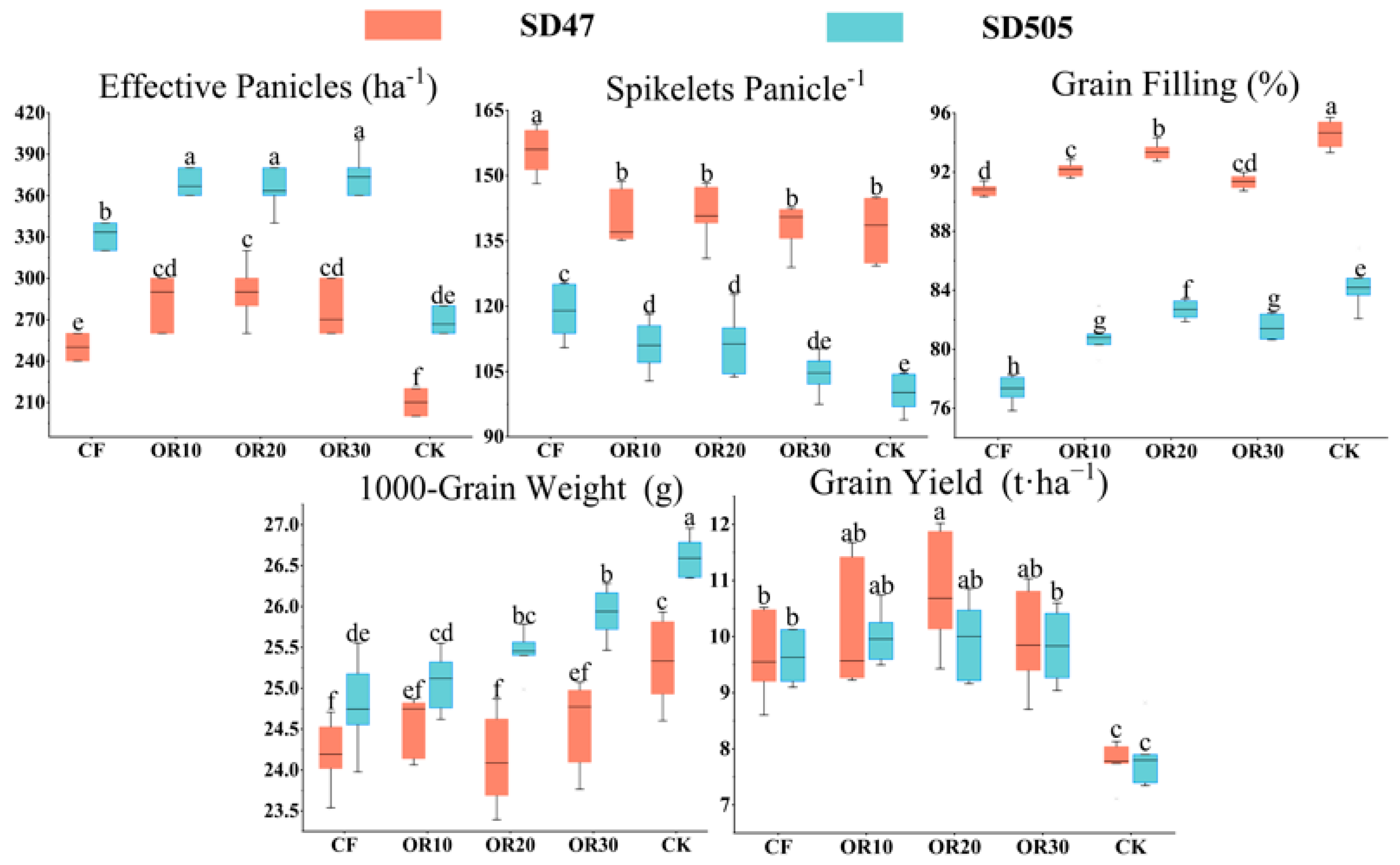

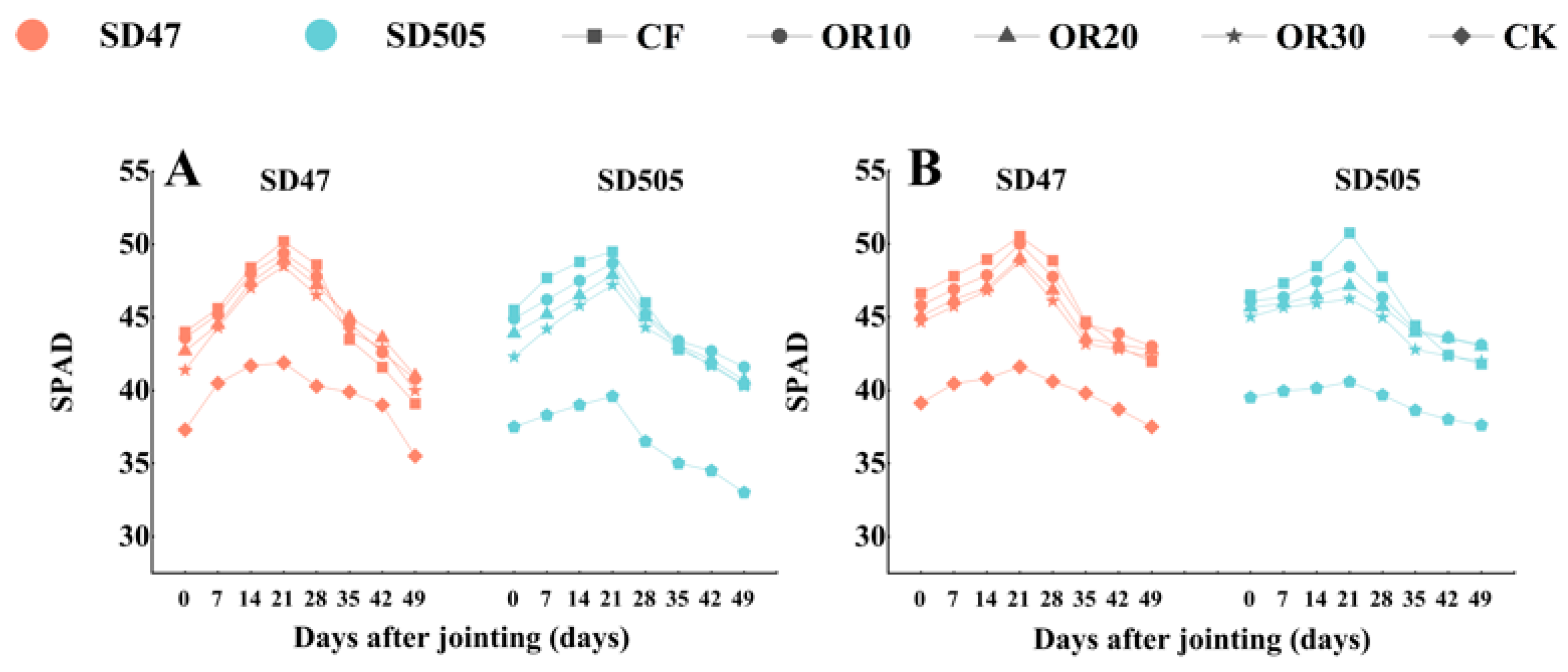


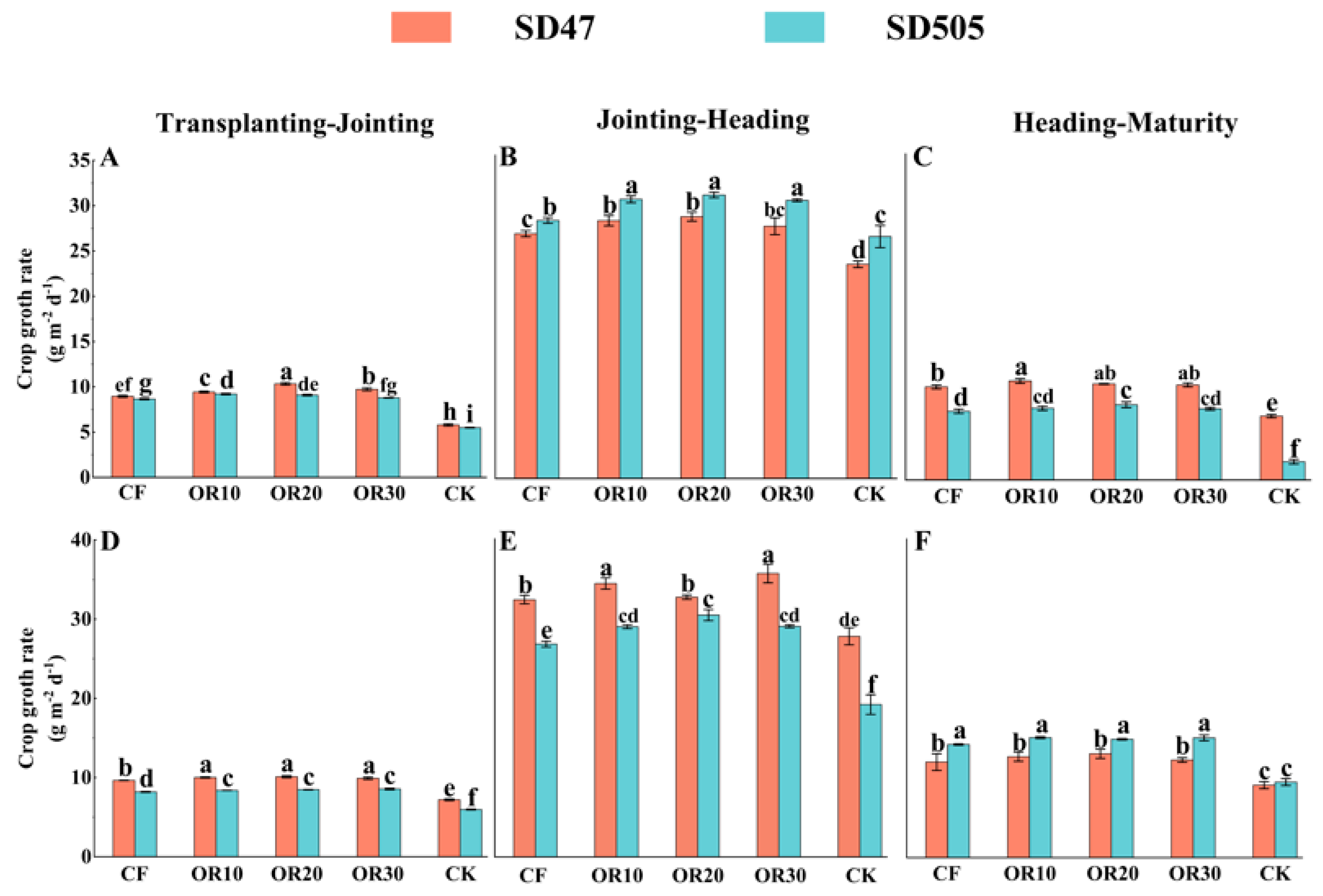
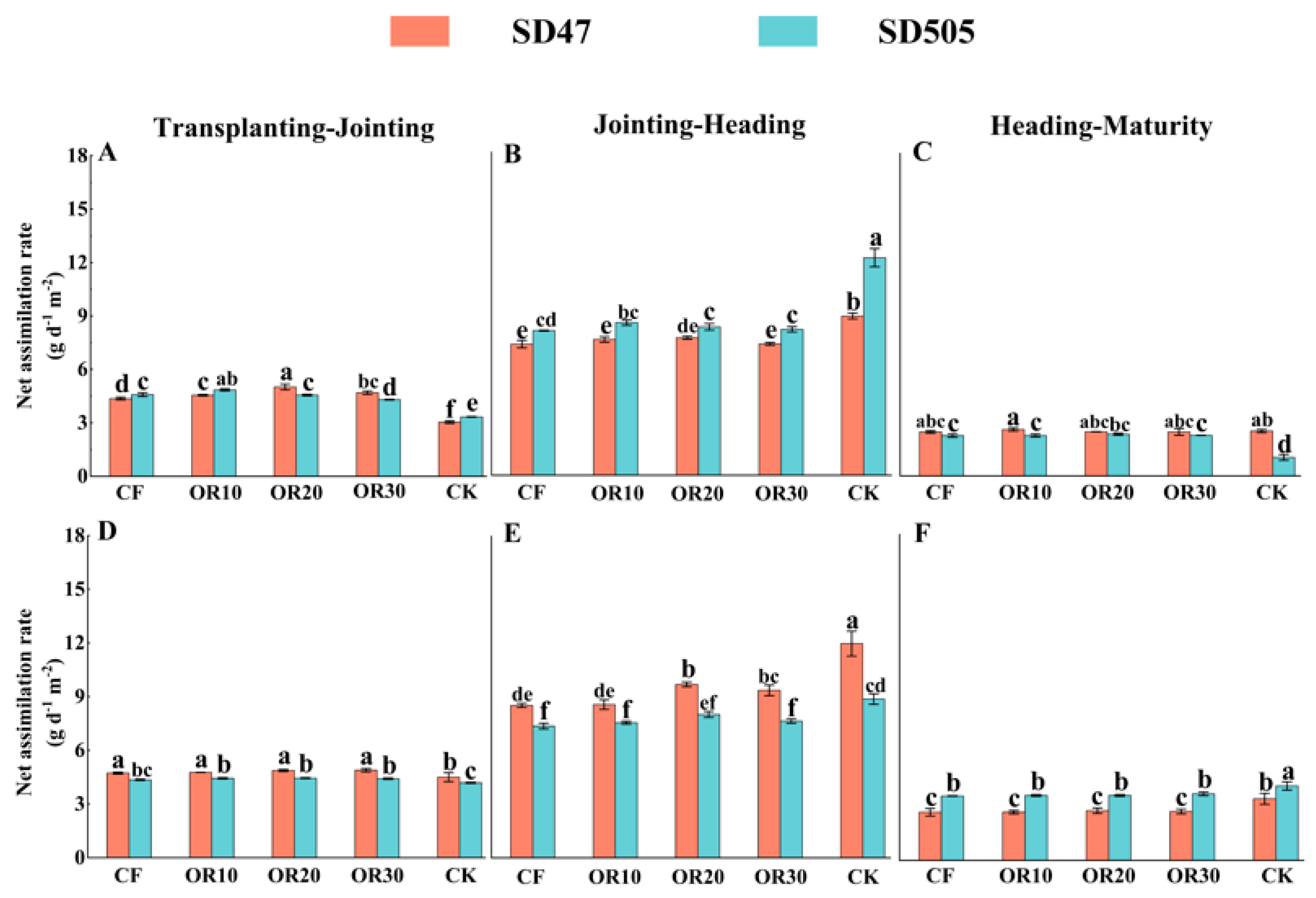
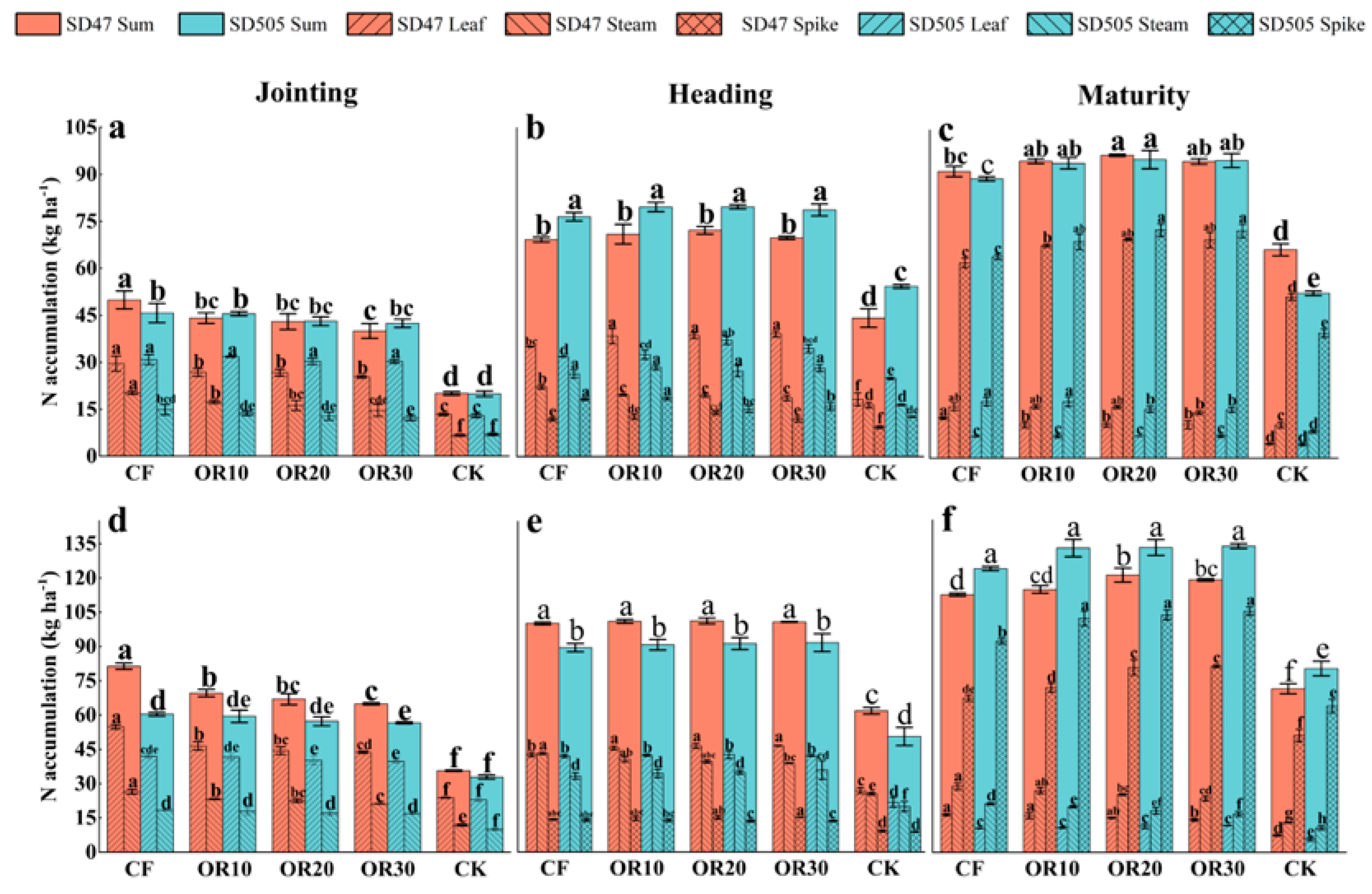


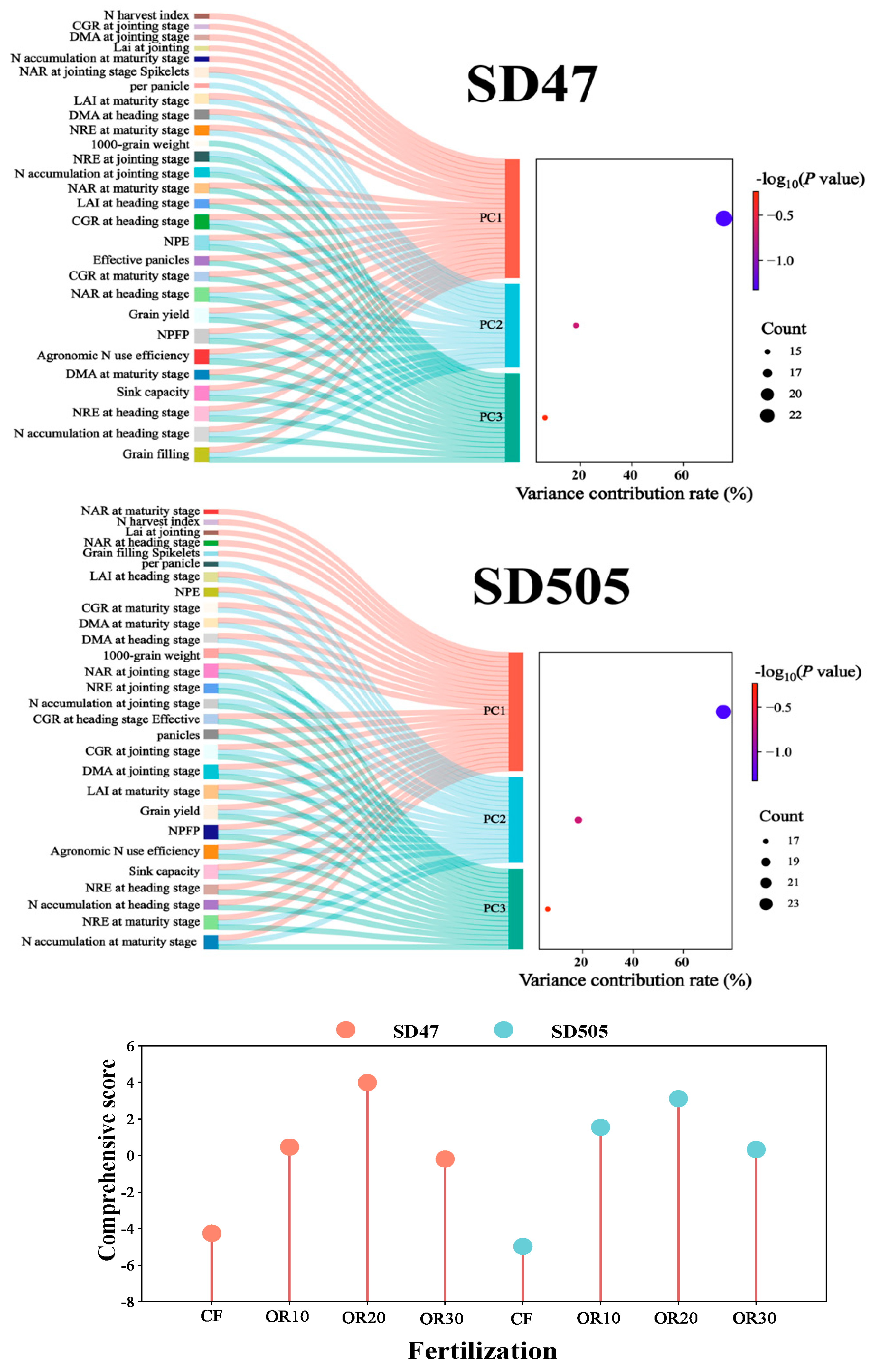
| Year | Cultivar | Fertilization | N Harvest Index | Agronomic N Use Efficiency | Partial Factor Productivity of Applied N | Physiological N Use Efficiency |
|---|---|---|---|---|---|---|
| 2021 | SD47 | CF | 0.6810 c | 10.2721 b | 60.5969 b | 56.154 ab |
| OR10 | 0.7156 b | 12.6912 ab | 63.016 ab | 61.4209 ab | ||
| OR20 | 0.7226 b | 16.2431 a | 66.5678 a | 73.4262 a | ||
| OR30 | 0.7352 b | 11.7806 ab | 62.1054 ab | 56.6943 ab | ||
| SD505 | CF | 0.7205 b | 12.3176 ab | 61.6984 ab | 46.0793 b | |
| OR10 | 0.7341 b | 14.5276 ab | 63.9084 ab | 47.9076 b | ||
| OR20 | 0.7636 a | 14.7221 ab | 64.1029 ab | 48.1682 b | ||
| OR30 | 0.7634 a | 14.4544 ab | 63.8352 ab | 46.5445 b | ||
| 2022 | SD47 | CF | 0.5985 e | 14.8932 b | 68.0725 b | 54.2246 abc |
| OR10 | 0.6262 d | 18.7289 ab | 71.9082 ab | 65.1464 ab | ||
| OR20 | 0.6662 c | 24.3131 a | 77.4924 a | 73.3086 a | ||
| OR30 | 0.6813 c | 17.26 ab | 70.4393 ab | 55.1050 abc | ||
| SD505 | CF | 0.7467 b | 12.0983 b | 66.6958 b | 36.5168 c | |
| OR10 | 0.7690 a | 14.2474 b | 68.8450 b | 41.112 bc | ||
| OR20 | 0.7791 a | 14.6534 b | 69.2510 ab | 41.8749 bc | ||
| OR30 | 0.7840 a | 12.6838 b | 67.2814 b | 36.8480 c |
| SD47 | SD505 | |||||
|---|---|---|---|---|---|---|
| Statistical parameters | PC1 | PC2 | PC3 | PC1 | PC2 | PC3 |
| Eigen value | 20.676 | 4.943 | 2.381 | 21.189 | 5.096 | 1.715 |
| % of Variance | 73.844 | 17.654 | 8.502 | 75.673 | 18.201 | 6.125 |
| Cumulative variance% | 73.844 | 91.498 | 100.000 | 75.673 | 93.875 | 100.000 |
| Factor loading | SD47 Eigen vectors | SD505 Eigen vectors | ||||
| N accumulation at the maturity stage | 0.958 | −0.024 | −0.287 | 0.995 | 0.017 | 0.095 |
| NRE at the maturity stage | 0.966 | 0.019 | −0.257 | 0.995 | 0.017 | 0.095 |
| Grain filling | 0.905 | 0.384 | 0.183 | 0.990 | −0.116 | −0.080 |
| N accumulation at the heading stage | 0.931 | 0.261 | 0.254 | 0.984 | −0.061 | 0.166 |
| NRE at the heading stage | 0.931 | 0.261 | 0.254 | 0.984 | −0.061 | 0.166 |
| Sink capacity | 0.754 | 0.459 | 0.471 | 0.980 | 0.175 | 0.091 |
| DMA at the heading stage | 0.998 | 0.007 | −0.054 | 0.977 | 0.021 | −0.213 |
| DMA at the maturity stage | 0.977 | −0.168 | 0.132 | 0.962 | 0.114 | −0.247 |
| Agronomic N use efficiency | 0.918 | 0.395 | 0.024 | 0.960 | 0.277 | 0.044 |
| NPFP | 0.918 | 0.395 | 0.024 | 0.960 | 0.277 | 0.044 |
| Grain yield | 0.918 | 0.395 | 0.024 | 0.960 | 0.277 | 0.044 |
| LAI at the maturity stage | 0.807 | 0.175 | −0.563 | 0.955 | 0.281 | 0.089 |
| NAR at the heading stage | 0.937 | 0.348 | 0.039 | 0.903 | −0.226 | −0.365 |
| CGR at the maturity stage | 0.731 | −0.501 | 0.463 | 0.896 | 0.319 | −0.308 |
| Lai at jointing | 0.523 | −0.706 | −0.477 | 0.896 | −0.444 | −0.026 |
| DMA at the jointing stage | 0.956 | −0.023 | −0.292 | 0.895 | 0.432 | 0.113 |
| CGR at the jointing stage | 0.957 | −0.008 | −0.291 | 0.887 | 0.447 | 0.121 |
| Effective panicles | 0.970 | −0.137 | 0.199 | 0.876 | −0.283 | 0.391 |
| N harvest index | 0.796 | −0.461 | −0.392 | 0.865 | −0.493 | −0.094 |
| NPE | 0.824 | 0.529 | 0.201 | 0.765 | 0.635 | -0.111 |
| CGR at the heading stage | 0.996 | 0.025 | 0.087 | 0.762 | −0.365 | 0.535 |
| LAI at the heading stage | 0.824 | −0.333 | 0.458 | 0.725 | 0.676 | −0.132 |
| Spikelets per panicle | -0.828 | 0.555 | −0.080 | −0.725 | 0.575 | −0.380 |
| NAR at the maturity stage | 0.360 | −0.786 | 0.503 | 0.715 | −0.105 | −0.691 |
| N accumulation at the jointing stage | -0.832 | 0.528 | 0.169 | −0.694 | 0.691 | 0.205 |
| NRE at the jointing stage | -0.832 | 0.528 | 0.169 | −0.694 | 0.691 | 0.205 |
| NAR at the jointing stage | 0.964 | 0.153 | −0.216 | 0.308 | 0.921 | 0.238 |
| 1000-grain weight | 0.022 | −0.959 | 0.283 | 0.682 | −0.725 | 0.101 |
Disclaimer/Publisher’s Note: The statements, opinions and data contained in all publications are solely those of the individual author(s) and contributor(s) and not of MDPI and/or the editor(s). MDPI and/or the editor(s) disclaim responsibility for any injury to people or property resulting from any ideas, methods, instructions or products referred to in the content. |
© 2025 by the authors. Licensee MDPI, Basel, Switzerland. This article is an open access article distributed under the terms and conditions of the Creative Commons Attribution (CC BY) license (https://creativecommons.org/licenses/by/4.0/).
Share and Cite
Guo, S.; Li, Y.; Wu, Z.; Liu, J.; Liang, C.; Wang, Y.; Wang, S.; Zhou, C.; Liu, J.; Mu, J. Effects of Partial Organic Fertilizer Substitution on Grain Yield, Nitrogen Use Efficiency, and Physiological Traits of Rice in Northeastern China. Agronomy 2025, 15, 1576. https://doi.org/10.3390/agronomy15071576
Guo S, Li Y, Wu Z, Liu J, Liang C, Wang Y, Wang S, Zhou C, Liu J, Mu J. Effects of Partial Organic Fertilizer Substitution on Grain Yield, Nitrogen Use Efficiency, and Physiological Traits of Rice in Northeastern China. Agronomy. 2025; 15(7):1576. https://doi.org/10.3390/agronomy15071576
Chicago/Turabian StyleGuo, Shimeng, Yimeng Li, Zhouzhou Wu, Jiaxin Liu, Chao Liang, Yue Wang, Shu Wang, Chanchan Zhou, Junfeng Liu, and Jingyi Mu. 2025. "Effects of Partial Organic Fertilizer Substitution on Grain Yield, Nitrogen Use Efficiency, and Physiological Traits of Rice in Northeastern China" Agronomy 15, no. 7: 1576. https://doi.org/10.3390/agronomy15071576
APA StyleGuo, S., Li, Y., Wu, Z., Liu, J., Liang, C., Wang, Y., Wang, S., Zhou, C., Liu, J., & Mu, J. (2025). Effects of Partial Organic Fertilizer Substitution on Grain Yield, Nitrogen Use Efficiency, and Physiological Traits of Rice in Northeastern China. Agronomy, 15(7), 1576. https://doi.org/10.3390/agronomy15071576






